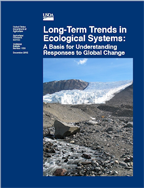| Abstract | The Eco Trends Editorial Committee sorted through vast amounts of historical and ongoing data from 50 ecological sites in the continental United States including Alaska, several islands, and Antarctica to present in a logical format the variables commonly collected. This report presents a subset of data and variables from these sites and illustrates through detailed examples the value of comparing long-term data from different ecosystem types. This work provides cross-site comparisons of ecological responses to global change drivers, as well as long-term trends in global change drivers and responses at site and continetal scales. Site descriptions and detailed data also are provided in the appendix sections.

⇒ This book is available for download (PDF format) below
⇒ Available from http://www.ars.usda.gov/is/np/indexpubs.html
⇒ Copies may be purchased in various formats (microfiche, photocopy, CD, print on demand) from the National Technical Information Service, 5285 Port Royal Road, Springfield, VA 22161, 800-553-6847, www.ntis.gov
Long-Term Trends in Ecological Systems: A Basis for Understanding Responses to Global Change (download PDF - 313 MB)
Download the book in PDF in it's entirety (above) or by section (below)
Contents
Introduction to Cross-Site Comparisons and History and Organization of the EcoTrends Project (8.29 MB)
-
Chapter 1: Long-Term Trends in Ecological Systems: An Introduction to Cross-Site Comparisons and Relevance to Global Change Studies
-
Chapter 2: History and Organization of the EcoTrends Project
Cross-Site Comparisons of Ecological Responses to Global Change Drivers (21.8 MB)
-
Chapter 3: Cross-Site Comparisons of Ecological Responses to Climate and Climate-Related Drivers
-
Chapter 4: Cross-Site Comparisons of State-Change Dynamics
-
Chapter 5: Patterns of Net Primary Production Across Sites
-
Chapter 6: Cross-Site Comparisons of Precipitation and Surface Water Chemistry
-
Chapter 7: Cross-Site Comparisons of Ecological Responses to Long-Term Nitrogen Fertilization
-
Chapter 8: Long-Term Trends in Human Population Growth and Economy Across Sites
-
Chapter 9: Disturbance Regimes and Ecological Responses Across Sites
-
Chapter 10: Cross-Site Studies “By Design”: Experiments and Observations That Provide New Insights
Long-Term Trends in Global Change Drivers and Responses at Site and Continental Scales (197 MB)
-
Chapter 11: Long-Term Trends in Climate and Climate-Related Drivers
-
Chapter 12: Long-Term Trends in Precipitation and Surface Water Chemistry
-
Chapter 13: Long-Term Trends in Human Demography and Economy Across Sites
-
Chapter 14: Long-Term Trends in Production, Abundance, and Richness of Plants and Animals
-
Chapter 15: Management and Policy Implications of Cross- and Within-Site Long-Term Studies
-
Chapter 16: Recommendations for Data Accessibility
-
Chapter 17: Long-Term Research Across Sites, Ecosystems, and Disciplines: Synthesis and Research Needs
Appendices & Index (79 MB)
-
Appendix 1: Site Descriptions
-
Appendix 2: Average (Standard Error) Maximum, Mean, and Minimum Air Temperature and Annual Precipitation at Each Site
-
Appendix 3: Average (Standard Error) Ice Duration, Sea Level, Streamflow, Water Clarity, and Water Temperature for Sites With Data
-
Appendix 4: Regression Coefficients and R2 Values for Nine Climatic Variables for Which Linear Regression Against Time Is Significant (p < 0.05)
-
Appendix 5: Annual Average (Standard Error) Nitrogen (as Nitrate) From Various Sources at Sites With Data
-
Appendix 6: Regression Coefficients and R2 Values for Nitrogen (as Nitrate) From Various Sources for Which Linear Regression Against Time Is Significant (p < 0.05)
-
Appendix 7: Annual Average (Standard Error) Nitrogen (as Ammonium) From Various Sources at Sites With Data
-
Appendix 8: Regression Coefficients and R2 Values for Nitrogen (as Ammonium) From Various Sources for Which Linear Regression Against Time Is Significant (p < 0.05)
-
Appendix 9: Annual Average (Standard Error) Sulfur (as Sulfate) From Various Sources at Sites With Data
-
Appendix 10: Regression Coefficients and R2 Values for Sulfur (Sulfate) From Various Sources for Which Linear Regression Against Time Is Significant (p < 0.05)
-
Appendix 11: Annual Average (Standard Error) Chloride From Various Sources at Sites With Data
-
Appendix 12: Regression Coefficients and R2 Values for Chloride From Various Sources for Which Linear Regression Against Time Is Significant (p < 0.05)
-
Appendix 13: Annual Average (Standard Error) Calcium From Various Sources at Sites With Data
-
Appendix 14: Regression Coefficients and R2 Values for Calcium From Various Sources for Which Linear Regression Against Time Is Significant (p < 0.05)
-
Appendix 15: Human Population and Economy Variables in 2000 for the Focal County of Each Site, as Grouped by Ecosystem Type
-
Appendix 16: Annual Average (Standard Error) Aboveground Net Primary Production (ANPP) at Sites With Data
-
Appendix 17: Other Measures of Average (Standard Error) Terrestrial Production at Sites With Data
-
Appendix 18: Average (Standard Error) Aquatic Production at Sites With Data
-
Appendix 19: Average (Standard Error) Biomass of Primary Producers (Plants, Algae) for Sites With Data
-
Appendix 20: Average (Standard Error) Plant Species Richness for Sites With Data
-
Appendix 21: Average (Standard Error) Animal Abundance for Sites With Data
-
Appendix 22: Average (Standard Error) Animal Species Richness for Sites With Data
-
Appendix 23: Regression Coefficients and R2 Values for Plant and Animal Variables for Which Linear Regression of Each Variable Against Time Is Significant (p < 0.05) and the Trend Appears Linear
-
Appendix 24: Lead Principal Investigator(s) (PI), Information Managers (IM), and Administrative Program of the LTER Programs
-
Appendix 25: Researchers Involved in the EcoTrends Project at Non-LTER Sites
-
Appendix 26: List of Stations and Length of Record for Each Climate Variable by Site
-
Appendix 27: List of Stations and Length of Record for Each Precipitation or Surface Water Chemistry Variable by Site
-
Appendix 28: List of Stations and Length of Record for Each Plant and Animal Variable by Site, as Grouped by Ecosystem Type
|



